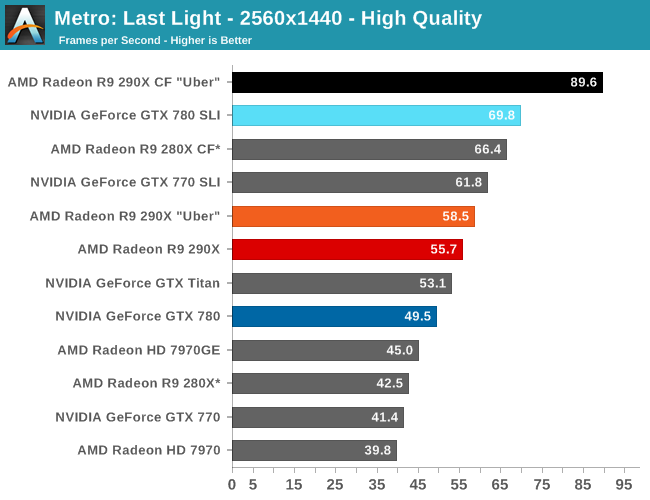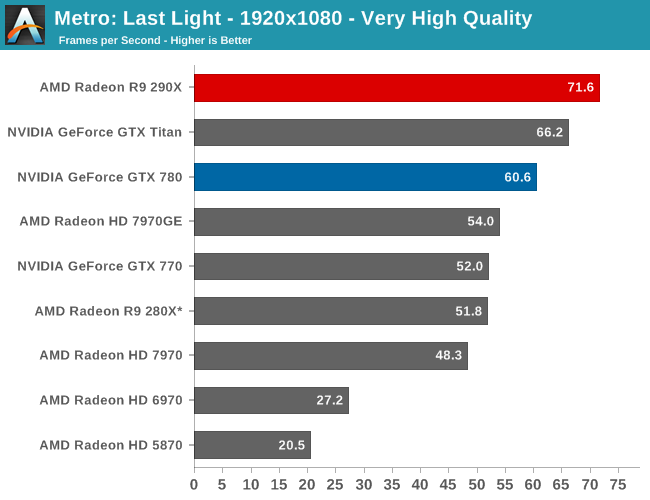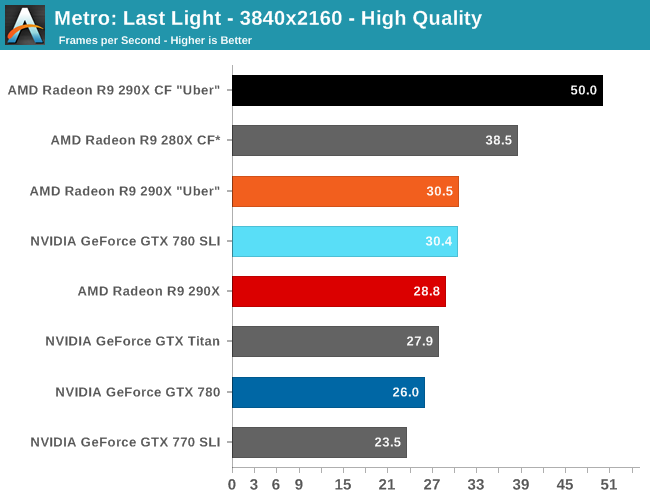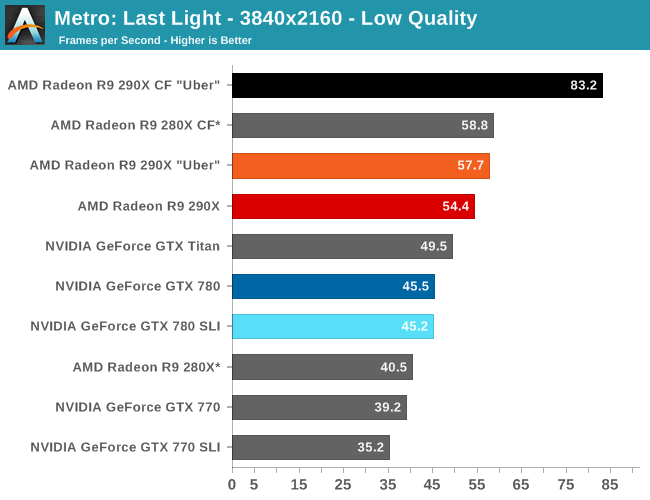The AMD Radeon R9 290X Review
by Ryan Smith on October 24, 2013 12:01 AM EST- Posted in
- GPUs
- AMD
- Radeon
- Hawaii
- Radeon 200
Metro: Last Light
As always, kicking off our look at performance is 4A Games’ latest entry in their Metro series of subterranean shooters, Metro: Last Light. The original Metro: 2033 was a graphically punishing game for its time and Metro: Last Light is in its own right too. On the other hand it scales well with resolution and quality settings, so it’s still playable on lower end hardware.


For the bulk of our analysis we’re going to be focusing on our 2560x1440 results, as monitors at this resolution will be what we expect the 290X to be primarily used with. A single 290X may have the horsepower to drive 4K in at least some situations, but given the current costs of 4K monitors that’s going to be a much different usage scenario.
With that said, for focusing on 4K on most games we’ve thrown in results both at a high quality setting, and a lower quality setting that makes it practical to run at 4K off of a single card. Given current monitor prices it won’t make a ton of sense to try to go with reduced quality settings just to save $550 – and consequently we may not keep the lower quality benchmarks around for future articles – but for the purposes of looking at a new GPU it’s useful to be able to look at single-GPU performance at framerates that are actually playable.
With that said, starting off with Metro at 2560 the 290X hits the ground running on our first benchmark. At 55fps it’s just a bit shy of hitting that 60fps average we love to cling to, but among all of our single-GPU cards it is the fastest, beating even the traditional powerhouse that is GTX Titan. Consequently the performance difference between 290X and GTX 780 (290X’s real competition) is even greater, with the 290X outpacing the GTX 780 by 13%, all the while being $100 cheaper. As we’ll see these results are a bit better than the overall average, but all told we’re not too far off. For as fast as GTX 780 is, 290X is going to be appreciably (if not significantly) faster.
290X also does well for itself compared to the Tahiti based 280X. At 2560 the 290X’s performance advantage stands at 31%, which as we alluded to earlier is greater than the increase in die size, offering solid proof that AMD has improved their performance per mm2 of silicon despite the fact that they’re still on the same 28nm manufacturing process. That 31% does come at a price increase of 83% however, which although normal for this price segment serves as a reminder that the performance increases offered by the fastest video cards with the biggest GPUs do not come cheaply.
Meanwhile for one final AMD comparison, let’s quickly look at the 290X in uber mode. As the 290X is unable to sustain the power/heat workload of a 1000MHz Hawaii GPU for an extended period of time, at its stock (quiet settings) it has to pull back on performance in order to meet reasonable operational parameters. Uber mode on the other hand represents what 290X and the Hawaii can do when fully unleashed; the noise costs won’t be pretty (as we’ll see), but in the process it builds on 290X’s existing leads and increases them by another 5%. And that’s really going to be one of the central narratives for 290X once semi-custom and fully-custom cards come online: Despite being a fully enabled part, 290X does not give us everything Hawaii is truly capable of.


Moving on, let’s talk about multi-GPU setups and 4K. Metro is a solid reminder that not every game scales similarly across different GPUs, and for that matter that not every game is going to significantly benefit from multi-GPU setups. Metro for its part isn’t particularly hospitable to multi-GPU cards, with the best setup scaling by only 53% at 2560. This is better than some games that won’t scale at all, but it won’t be as good as those games that see a near-100% performance improvement. Which consequently is also why we dropped Metro as a power benchmark, as this level of scaling is a poor showcase for the power/temp/noise characteristics of a pair of video cards under full load.
The real story here of course is that it’s another strong showing for AMD at both 2560 and 4K. At 2560 the 290X CF sees better performance scaling than the GTX 780 SLI – 53% versus 41% – further extending the 290X’s lead. Bumping the resolution up to 4K makes things even more lopsided in AMD’s favor, as at this point the NVIDIA cards essentially fail to scale (picking up just 17%) while the 290X sees an even greater scaling factor of 63%. As such for those few who can afford to seriously chase 4K gaming, the 290X is the only viable option in this scenario. And at 50fps average for 4K at high quality, 4K gaming at reasonable (though not maximum) quality settings is in fact attainable when it comes to Metro.
Meanwhile for single-GPU configurations at 4K, 4K is viable, but only at Metro’s lowest quality levels. This will be the first of many games where such a thing is possible, and the first of many games where going up to 4K in this manner further improves on AMD’s lead at 4K. Again, we’re not of the opinion that 4K at these low quality settings is a good way to play games, but it does provide some insight and validationg into AMD’s claims that their hardware is better suited for 4K gaming.










396 Comments
View All Comments
Da W - Thursday, October 24, 2013 - link
The reference cooler is noisy as hell, but it's a blower. At least it doesn't dump all the heat inside your case and let your other case fans handle it. It depends what you're looking for.Still make as much noise as the 5870 did, and it was a commercial success.
slickr - Thursday, October 24, 2013 - link
Didn't think AMD will deliver, in fact I thought from seeing some initial benchmarks that AMD took over 6 months just to deliver a graphic card slower than Titan and that even with a cheap price it wouldn't be enough, boy was I wrong.This card beats Titan in so many games and in so many resolutions and is almost $500 cheaper, its also $100 cheaper than the GTX 780 and anywhere from 5% to 20% faster than the 780, that is just amazing.
Hopefully this trickles down to the medium range cards and we are going to see cards like the 280x go for less than $250.
I mean unless Nvidia positiones the Titan at $550 as well, then I don't think it will sell very much at all. In the 290x you have a better performing card at almost half the price, Nvidia has its work cut out for them and I sure hope the 780 TI edition really brings in the performance and price as well.
eanazag - Thursday, October 24, 2013 - link
I'm sporting a Nvidia GPU in my rig. I don't see any option for Nvidia than to reduce both the Titan, 770, and 780 in cost. I can't expect the 780 Ti performance to trump the Titan. I will say that there is power and cooling room for Nvidia to ratchet things up and make this interesting. This is bold move on AMDs part and does wonders for consumers. Based on some of the other comments current news does not kill off either brand by the way. PC gaming and desktops are not dead.....kwrzesien - Thursday, October 24, 2013 - link
Ryan, can we get a pipeline article or retweet this article when it is complete? Thanks!spiked_mistborn - Thursday, October 24, 2013 - link
Nice job AMD! Competition is good! Also, feel free to use my GSYNC idea about putting a frame buffer in the display and letting the video card control the refresh rate. This post is from March 2013. Apparently adding a dash to make it G-Sync makes it different somehow. http://techreport.com/discussion/24553/inside-the-...Sorodsam - Thursday, October 24, 2013 - link
I'm surprised no one's commented on the new "AMD Center", or this troubling text:"You've landed on the AMD Portal on AnandTech. This section is sponsored by AMD."
There's a big difference between a site that runs an occasional AMD ad and a site with an entire section that's expressively "sponsored by AMD", especially considering AnandTech's (former?) guiding principle that product reviewers shouldn't be aware of who exactly is buying advertising and when. They can hardly be unaware of it now.
MrMaestro - Thursday, October 24, 2013 - link
The reason people aren't commenting on it is because it's already been commented on. Take a look at the article announcing AMD Centre. That is the appropriate place for such comments.anevmann - Thursday, October 24, 2013 - link
Ryan, will this card require PCIe 3.0 for gaming?Can you do a test with and without PCIe 3.0? I really want this card, but I wanna know in advance if I have to upgrade my system.
A
Ryan Smith - Monday, October 28, 2013 - link
I can't promise when it will be done (given the insanity of our schedule over the next 3 weeks), but at some point we will follow this up with a reprise article, that among other things will cover PCIe bandwidth vs. Crossfire scaling, CF testing in quiet mode, and some noise equalization to see what fan levels it would take to match a GTX 780 and what the resulting performance would look like.Anyhow, for a single card setup none of my data thus far supports PCIe 3.0 being a requirement. We're not to the point yet where PCIe 2.0 x16 is a general gaming bottleneck.
Hung_Low - Thursday, October 24, 2013 - link
Is 290X really the absolute maxed out version Tahiti? Or did it also leave a lot of room like Titan is for GK110.Perhaps the GPUs used in 290x are those Tahiti's with imperfection, with the high quality Tahiti's saved for extreme edition 290x/290x+ ?